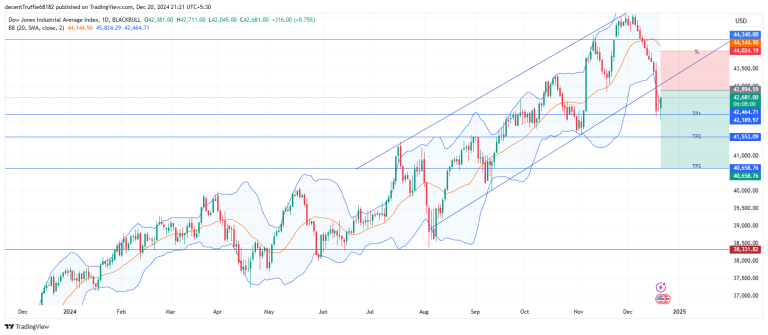Novo Nordisk A/S (CPH: NOVO-B) is being punished this morning after posting a disappointing update related to CagriSema.
The pharmaceutical behemoth said its experimental weight-loss treatment helped patients lower their weight by 22.7% in a late-stage trial – lower than 25% it had originally expected.
Novo Nordisk stock was down nearly 25% at one point on Friday. Its anti-obesity rival, Eli Lilly & Co, in comparison, jumped as much as 8.0% in premarket.
Others that are positioned to compete with Novo Nordisk in the weight loss market include Amgen, Zealand Pharma, and more recently, Merck & Co Inc.
Why does CagriSema news matter for Novo Nordisk stock
The announcement is significant for Novo Nordisk stock as the management expected CagriSema to emerge as the next-generation treatment for obesity.
CagriSema is a two-drug injectable that combines Cagrilintide and Semaglutide.
Cagrilintide is a novel approach for weight loss but Semaglutide is the active ingredient of the company’s Wegovy as well.
The 68-week phase three trial involving CagriSema saw participation from 3,400 people who were suffering from obesity or were otherwise overweight, as per the press release the European drugmaker published on Friday.
Note that Novo Nordisk is scheduled to share the outcome of a phase three trial that’s testing CagriSema in obese/overweight adults with type 2 diabetes in the coming year as well.
Novo Nordisk stock is now down more than 45% versus its high in late June.
CagriSema outperformed Wegovy in weight loss
On the plus side, the new weight-loss treatment was “on part with best-in-class treatments.”
That’s because CagriSema delivered better results in terms of helping people lower their body weights than Wegovy in the late-stage trial.
“CagriSema demonstrated superiority over both Semaglutide and Cagrilintide in monotherapy in REDEFINE 1 trial. This was achieved even though only 57% of patients reached the highest dose,” Martin Holse Lanage – an executive vice president of Novo Nordisk said in a press release today.
Still, Novo Nordisk stock tanked sharply this morning as investors focused more on the fact that CagriSema failed to meet the company’s original expectations in the phase three trial.
Novo Nordisk is not bailing on CagriSema
Novo Nordisk will continue to “further explore the additional weight-loss potential of CagriSema” and expects to seek regulatory approval for the treatment by the end of 2025.
Shares of the pharmaceutical giant are still slipping at writing perhaps because it wasn’t the first setback for Novo Nordisk this month.
Earlier in December, a Lilly sponsored trial that drew head-to-head comparison between its Zepbound and Novo Nordisk’s Wegovy established the former’s superiority as an anti-obesity treatment.
Zepbound enabled patients lower their body weights by more than 20% in that trial over 72 weeks versus a significantly lower 13.7% reduction in weight observed for Wegovy.
Novo Nordisk shares do not currently pay a dividend to appear any more attractive for the income investors either.
The post Novo Nordisk stock just tanked 25%: here’s what happened appeared first on Invezz
Shares of Humacyte Inc (NASDAQ: HUMA) nearly doubled on Friday after receiving full approval for its flagship SYMVESS product from the US Food and Drug Administration (FDA).
Regulatory approval for the company’s bioengineered human tissue marks a major step forward in regenerative medicine and trauma care.
Humacyte stock sure has made its investors a happy lot today – but a more important question is: would it be able to sustain its recent gains heading into the next year?
Unfortunately, there’s reason to believe it may not.
Insiders have been unloading Humacyte stock
Recent insider moves have not been particularly encouraging in Humacyte.
Brady W. Dougan – its board member who’s married to chief executive Laura Niklason sold a total of 1.5 million shares of Humacyte via his LLC called Ayabudge for $6.6 million in November.
Insider selling is often considered negative because it signals a lack of confidence in the company’s future prospect.
That’s because executives and board members usually have more information than an average investor.
So, when they trim or sell their stake entirely, it typically suggests they see the stock as overvalued or expect the company to face challenges ahead.
If any of those assumptions prove true, Humacyte stock may end up losing today’s gain over the next few weeks.
HUMA is yet to turn a quarterly revenue
FDA’s approval for Humacyte’s SYMVESS sure is a big news for regenerative medicine.
But one must not forget that it continues to be a pre-revenue company for now. Humacyte lost $39.2 million in its third financial quarter – a significant increase from $26 million a year ago.
The Nasdaq listed firm ended its Q3 with $71 million in cash, cash equivalents, and restricted cash, which suggests it may have to dilute its shareholders to fund operations moving forward.
What’s also worth mentioning is that Humacyte stock was worth about $3.0 before today’s gain.
So, there’s possibility that investors are manipulating its modest price tag to pump it up before unloading all of it to lock in sizeable profits.
Humacyte faces litigation for misleading investors
Finally, Humacyte is currently grappling with a class-action lawsuit over allegedly misleading investors about the regulatory compliance of its production facilities.
The biotech firm has failed to share critical information with its investors about its business and operations.
If such allegations prove to be true, “the company’s conduct constitutes a serious violation of securities laws,” as per Reed Kathrein of Hagens Berman – a law firm investigating the matter.
And it’s not like Humacyte stock pays a dividend to reward its shareholders for their patience through the turbulence.
Nonetheless, Wall Street has a consensus “buy” rating on Humacyte shares with price targets going as high as $25 at writing.
The post Humacyte stock may fail to sustain today’s gains: find out more appeared first on Invezz
Bloomberg reports Nike Inc. is bracing for a turbulent phase as new Chief Executive Officer Elliott Hill leads efforts to revitalize the sportswear giant.
Hill, who assumed the role in October, announced a series of strategic shifts during the company’s latest earnings call.
These initiatives aim to reignite demand, particularly in sports-related product lines, but come with the risk of short-term financial strain.
Nike anticipates revenue in the current quarter will decline in the low double digits—a steeper drop than the 7.7% decrease recorded in the previous period.
The company’s focus is now on clearing excess inventory to make room for new product launches slated for next autumn and the holiday season.
Despite surpassing analysts’ expectations in the recent quarter for revenue, profit, and gross margin, Nike’s shares have lost 29% of their value this year, reflecting investor concerns about the company’s ability to navigate a challenging landscape.
Why Elliott Hill says change will take time
To address slowing demand for its iconic lifestyle shoe lines, such as the Air Force 1, Nike is reshuffling its priorities under Hill’s leadership.
The company is eliminating discounts for online sales while ramping up investments in sports marketing.
Hill has already reorganized senior management, appointing new leaders in human resources, legal, and sports marketing, and has closed its digital sneaker division to streamline operations.
Nike is also tackling the issue of excess inventory, which has weighed on its ability to introduce fresh designs.
The company plans short-term liquidation measures to clear warehouse space, acknowledging the potential for a temporary dip in financial performance.
However, this approach aligns with Hill’s long-term strategy to regain momentum in core markets.
Notably, the latest earnings report shows stabilization in Nike’s overall performance, with all regions except China outperforming expectations.
Analysts have highlighted robust wholesale and apparel sales as bright spots in the company’s results.
Renewed focus on sports and fresh designs
Hill has been meeting with key figures in professional sports, including league commissioners in football, basketball, and soccer, as part of Nike’s plan to strengthen its presence in the athletic sector.
By prioritizing sports-related marketing and product innovation, the company aims to recapture its position as a global leader in athletic wear.
The absence of groundbreaking designs and declining interest in lifestyle products have been key challenges for Nike.
As a response, the company is looking to freshen up its offerings, with new products expected to launch in the coming months.
These efforts underscore Hill’s commitment to reinvigorating Nike’s brand image and market share.
While short-term hurdles remain, the company’s leadership believes these measures are necessary for long-term growth.
Investors, however, remain cautious, as the market awaits tangible signs of a turnaround.
The post Why Nike’s CEO believes turnaround efforts could hurt in the short term appeared first on Invezz
The post GameStop stock is at risk: here’s one potential solution appeared first on Invezz
Bitcoin, the flagship cryptocurrency, has experienced a turbulent 24 hours, fluctuating around the $100,000 mark as the Federal Reserve’s cautious outlook on interest rate cuts dampened enthusiasm for speculative investments.
This volatility underscores the complex interplay between monetary policy, market sentiment, and Bitcoin’s own inherent fluctuations, creating an environment of both opportunity and risk.
A battle at the $100,000 level
The largest digital asset initially dropped roughly 1% to $99,588 in New York, hitting a low of $98,760 earlier in the day, about $10,000 off from the record high earlier in the week.
It briefly reclaimed the six-figure level before falling back again, illustrating the delicate balance between bullish momentum and market pressures.
This volatility was also felt by other cryptocurrencies, including Ether and the meme-crowd favorite Dogecoin, which also struggled to maintain their upward trajectory.
The Fed’s cautious stance
The Federal Reserve’s decision to lower borrowing costs for the third consecutive time, while signaling a reduced pace of future rate reductions in 2025, has created unease in the markets.
Fed Chair Jerome Powell emphasized that more progress on inflation is needed before further loosening monetary policy, which cooled off the speculative interest in riskier assets like Bitcoin.
As IG Australia Pty Market Analyst Tony Sycamore pointed out to Bloomberg, “The result of the Fed meeting shouldn’t have surprised investors watching ‘the recent run of warm US inflation and activity data.’ However, it has served as the catalyst to wash away some of the speculative excesses that flowed into risk assets, including stocks and Bitcoin, following the US election.”
Market crosscurrents: US politics, treasury yields, and Bitcoin’s momentum
The Fed’s decision had a ripple effect across markets, strengthening the dollar, and weighing down global stocks and bonds.
Furthermore, a spat over a funding bill added to market nervousness by raising the risk of a partial US government shutdown.
US equity futures also wavered on Thursday, underscoring the widespread unease in the markets.
Despite this volatility, Bitcoin has seen nearly 50% gains since the US election on November 5, buoyed by President-elect Donald Trump’s vow to ease regulations on crypto and his backing of the idea of creating a national stockpile of Bitcoin.
Trump’s crypto embrace: a tailwind for Bitcoin
“All signs point to a good floor and outlook for Bitcoin” even if some traders were disappointed about the Fed meeting and took profits, according to Paul Veradittakit, a managing partner at Pantera Capital.
Trump’s support for crypto has overshadowed concerns about stretched momentum and the lack of traditional valuation metrics for the digital asset.
This stance is in stark contrast to President Joe Biden’s outgoing administration, which imposed a clampdown on the industry following a market downturn in 2022 that exposed risky practices and fraud.
Hedging against declines
Following the Fed’s policy announcements, Sean McNulty, director of trading at liquidity provider Arbelos Markets, reported a surge in demand for options to hedge against Bitcoin declines.
Zann Kwan, chief investment officer at the Revo Digital Family Office, told Bloomberg that a retreat to the low $90,000s is possible for a very short period, reflecting the current market caution.
The post Bitcoin’s $100K test: Fed’s cautious stance sparks market volatility appeared first on Invezz
Despite sluggish demand in the retail jewellery market, Beijing-based Laopu Gold has emerged as a standout success.
With revenue skyrocketing 148% year-on-year in the first half of 2024 and stock prices surging 437% since its June Hong Kong listing, the jeweller has become the best performer on the Hang Seng Composite Index this year.
Since its market debut, the 14-day relative strength index (RSI) of Laopu Gold’s stock has surpassed 80 on at least five occasions—a notable achievement often signalling a strong outperformer.
While an RSI above 70 typically suggests the stock may be overbought, analysts remain optimistic.
All 14 analysts covering the company have issued buy recommendations, according to Bloomberg data.
The Hermès of gold: what’s behind Laopu’s irresistible allure?
Laopu Gold has maintained an impressive gross margin above 40% over the past three years, far surpassing the industry average of 8% to 20%.
Founded 15 years ago, the jewellery maker distinguishes itself by focusing on heritage gold jewellery inspired by Buddhism, priced as high-end luxury items rather than by weight.
This strategy has elevated the brand, drawing comparisons to global icons like Cartier and Tiffany.
Offering fixed prices for its jewellery, it has distanced itself from fluctuations in gold prices that typically influence consumer behaviour in China.
The brand also distinguishes itself with unique practices: it avoids franchising, operates only directly managed stores, and exclusively uses “old craft” pure gold, with no low-carat options.
This approach has earned Laopu the moniker “Hermès of gold,” cementing its place as a luxury leader in China’s jewellery market.
Laopu’s “relatively small size” is also an advantage that allows it to focus on quality over quantity, said Mark Tanner, managing director of consultancy China Skinny in Shanghai, as reported by Bloomberg.
The brand “fills a space” in the untapped China-made luxury market, he said.
With just 33 stores, the brand’s exclusive presence enhances its appeal among China’s high-net-worth clientele.
A 7.2-gram Laopu necklace can retail for 11,230 yuan (US$1,540)—a premium far above its weight-based value—further solidifying its luxury standing.
For wealthy patrons seeking bespoke pieces that incorporate classic Chinese motifs, prices can reach hundreds of thousands of yuan.
Laopu Gold stock bucks broader market trends
While many Chinese retailers await government stimulus to boost consumption, Laopu Gold has already carved a thriving niche.
Its focus on wealthy repeat customers has paid dividends, with loyalty members making purchases five times or more doubling since 2021.
JPMorgan Chase analysts forecast Laopu’s revenue to grow by 55% annually between 2024 and 2026.
The company plans to expand its footprint with 10 new stores in mainland China and five across Hong Kong, Macau, Singapore, and other Asian cities within three years.
The jeweller also capitalizes on digital sales via Alibaba’s Tmall, JD.com, and WeChat, enhancing its reach beyond brick-and-mortar locations.
Despite its successes, Laopu Gold faces potential hurdles. Maintaining its aura of exclusivity while scaling operations will be critical, Tanner said.
Additionally, fluctuating gold prices and intensifying competition from established brands like Chow Tai Fook and Cartier may test its resilience.
The post Laopu Gold stock surges 437% since June listing: what’s fueling the rally? appeared first on Invezz
The largest strike in Amazon’s history, organized by the International Brotherhood of Teamsters, erupted across the US this week, marking a significant escalation in the ongoing battle for better wages, benefits, and workplace safety.
Thousands of Amazon workers and Teamsters affiliates staged protests outside fulfillment centers in cities like New York, Atlanta, San Francisco, and Chicago, with demonstrations aimed at forcing the online retail giant to the bargaining table.
This industrial action, coming during the critical pre-Christmas rush, has added pressure to Amazon’s sprawling logistics network, already under scrutiny for alleged anti-union tactics and workplace safety concerns.
Amazon workers strike: seven major sites
The Amazon workers strike has already impacted key logistics hubs across the US, with picket lines forming early at delivery stations in New York City, Atlanta, San Francisco, and Southern California.
The union, representing nearly 9,000 Amazon workers from 20 bargaining units, described this as a “historic effort” to secure a union contract.
Amazon has refused to recognize the Teamsters as representatives of its workers, alleging that the union coerced employees into joining.
While the striking workers make up less than 1% of Amazon’s global workforce of 1.5 million employees, the disruption has been felt.
At a facility in San Francisco, protesters blocked entrances, forcing delivery vans to reroute.
Similar scenes unfolded in New York, where striking workers gathered outside a key delivery station, demanding safer working conditions and higher wages.
Amazon has pushed back against these actions, claiming that the majority of protesters are “outsiders” not employed by the company.
According to a company spokesperson, the strikes have had minimal impact on operations and customer deliveries.
Yet, the union asserts that these demonstrations are only the beginning, with plans to extend the strike to more locations, including Staten Island, home to Amazon’s first unionized warehouse.
Amazon workers strike 2024: what is the reason?
Amazon workers have long accused the company of prioritizing profits over safety, with injury rates reportedly higher than the industry average.
A Senate investigation earlier this year highlighted safety concerns, adding weight to the Teamsters’ demands.
The union has also criticized Amazon’s anti-union strategies, which include hiring consultants and challenging unionization efforts through federal regulators.
Despite these allegations, Amazon touts its pay and benefits as industry-leading, with an average hourly wage of $22 for warehouse and delivery workers, plus health insurance and retirement plans.
However, critics argue that the compensation falls short of what unionized workers in similar roles earn, particularly when considering the physical demands and injury risks associated with Amazon’s operations.
The strike also underscores the broader challenges facing the labor movement, which has struggled to unionize the tech giant’s workforce.
The Teamsters are relying on a strategy of escalating industrial action rather than traditional union elections, aiming to force Amazon into negotiations through widespread disruption.
Amazon workers’ strike threatens holiday logistics delays
The Amazon workers’ strike could pose a significant challenge to the company’s ability to manage its holiday season logistics.
Although Amazon claims its network is resilient, experts suggest that sustained action could lead to delays, particularly in major cities like New York, Atlanta, and Chicago.
The strike also highlights the complexities of Amazon’s business model, which relies heavily on third-party contractors for delivery operations.
The company has argued that these workers are not directly employed by Amazon, a claim disputed by the National Labor Relations Board, which considers Amazon a joint employer.
This distinction has become a focal point in the broader debate over the company’s labor practices.
As the strike continues, the Teamsters are expected to ramp up their efforts, with plans to target additional facilities in the coming weeks.
Whether Amazon will engage with the union remains uncertain, but the growing support for the strike, both from workers and the public, suggests that the company may face increasing pressure to address its labor practices.
The post Amazon workers strike: key facilities disrupted amid escalating labor tensions appeared first on Invezz
Breaking up companies into smaller, independent entities is proving to be a winning formula for investors.
Spinoffs, often pursued to create shareholder value, have delivered extraordinary returns in 2024.
The Bloomberg Spinoff Index, which tracks companies separated from their parent firms over the past three years, has surged 63% this year—more than double the S&P 500’s 24% rise.
Several standout companies are leading the charge. Victoria’s Secret, spun off from Bath & Body Works, has gained 62% this year, while BellRing Brands, a former part of Post Holdings, has climbed 37%.
The crown jewel of spinoffs, however, is Constellation Energy, which was separated from Exelon in 2022 and has soared 95% in 2024 alone.
Not all spinoffs are created equal
While spinoffs have been largely successful, not every breakup yields stellar results.
In a Barron’s report, Trivariate Research’s Adam Parker points out that spinoffs involving companies in different industries than their parent firms tend to perform better, but high-quality companies should never do a spin.
“Something about breaking up a high-quality company creates dis-synergies,” he writes.
Recent examples highlight this divide. While GE Vernova, spun off from General Electric, has gained a staggering 154%, Kenvue, separated from Johnson & Johnson, has fallen more than 20% since its 2023 debut.
Similarly, Solventum spun off from 3M, has declined 17% this year, underscoring that spinoffs are not a guaranteed path to success.
GE Vernova: a spinoff success story
One of the most talked-about spinoffs of 2024 is GE Vernova, the renewable energy-focused unit of General Electric.
When Larry Culp took over GE in 2018, the company faced serious doubts about its future.
Culp’s strategy to split GE into three distinct businesses—GE Healthcare, GE Vernova, and GE Aerospace—has proven transformative.
GE Vernova, initially viewed as a “problem child,” has become a star performer, delivering a 154% return since its spin-off.
GE Aerospace has also shined, gaining 62% this year and 194% since GE Healthcare’s spin-off in early 2023.
These successes are setting a high bar for future spinoffs, making it easier for companies to pitch such moves to stakeholders.
Can Honeywell, and FedEx replicate GE’s success?
The success of spinoffs like GE Vernova has sparked a wave of new announcements from major corporations.
In the past month alone, companies like Honeywell, FedEx, and Comcast have announced plans to spin off divisions to unlock value and drive growth.
Honeywell, under pressure from activist investor Elliott Investment Management, is exploring strategic alternatives for its aerospace unit, a move that has excited Wall Street.
“We do believe there is upside simply on a sum of the parts basis…but more importantly, a simpler model should allow for better focus, prospective growth, and even higher valuation,” writes UBS analyst Amit Mehrotra, who has a Buy rating and a $298 price target on the stock, up 31% from Thursday’s close of $226.88.
FedEx has also announced plans to spin off its freight business, aiming to unlock the division’s value. The news drove the stock up over 10% in after-hours trading.
The optimism appears justified, as FedEx trades at 12.9 times its 12-month forward earnings, significantly lower than freight-focused companies like Old Dominion Freight Line and Saia, which command valuations exceeding 30 times earnings.
Ariel Rosa of Citigroup however has raised concerns about the plan.
In a note issued before the announcement, Rosa highlighted that FedEx’s freight business has lagged behind its peers in growth, potentially limiting its valuation.
Additionally, FedEx previously emphasised the synergy between its freight and express divisions, particularly in cross-selling services.
Splitting the two could pose challenges, making it difficult to achieve a clean separation and potentially driving customers to competitors.
Despite maintaining a “buy” rating on the stock due to its low valuation and other positive factors, Rosa expressed concerns about potential downside risks emerging in early 2025.
“While there is logic in spinning the business to unlock value, we see significant execution risk and remain unconvinced that a spin is in the best interest of long-term shareholders,” he wrote.
The post Honeywell and FedEx spinoff plans: can investors hope for a GE Vernova-like success? appeared first on Invezz
Donald Trump, the president-elect of the United States, has issued another warning to the European Union, threatening tariffs if its member states do not increase their purchase of American oil and gas.
The statement, made via Truth Social, signals Trump’s intent to leverage energy exports to address the US-EU trade deficit, a long-standing grievance.
With the US being the world’s largest producer of crude oil and a top exporter of liquefied natural gas (LNG), the threat places significant pressure on the EU to act.
Trump’s hardline stance comes just over a month before his inauguration, during a high-profile visit to Paris for the reopening of the Notre Dame Cathedral, where trade tensions were a key topic of discussion.
EU braces for new US trade measures
European officials, recalling the tumultuous trade policies of Trump’s previous administration, have been preparing for renewed tensions.
In 2017, Trump imposed tariffs on European steel and aluminum, citing national security concerns, catching the bloc by surprise.
Since then, the EU has overhauled its trade doctrine, implementing robust mechanisms to counter coercive practices.
The EU’s recently adopted anti-coercion instrument empowers the European Commission to impose retaliatory tariffs or other punitive measures in response to politically motivated trade restrictions.
This tool is part of a broader strategy to protect the bloc’s interests under challenging trade dynamics.
The foreign subsidies regulation allows the commission to block foreign companies benefiting from unfair state support from participating in public tenders or mergers within the EU.
German Foreign Minister Annalena Baerbock addressed these preparations during a Group of Seven meeting in Italy last month.
She emphasized that Europe is ready to respond decisively if Trump pursues an “America First” approach, reinforcing the bloc’s commitment to unity in the face of external pressure.
US is a major energy supplier to Europe
The US remains a vital energy supplier to Europe, with American LNG accounting for over half of the EU’s gas imports last year.
These imports have been pivotal in reducing the bloc’s reliance on Russian energy following the Ukraine conflict.
However, Trump’s demands for increased purchases highlight the underlying tensions in transatlantic trade relations.
The US has also emerged as a major crude oil exporter, supplying markets across Europe and Asia.
Trump’s rhetoric underscores his administration’s focus on leveraging energy exports as a tool to address trade imbalances.
While Europe is a key destination for American oil and gas, Trump’s tariff threats add a layer of complexity to an already delicate trade partnership.
Trump’s grievances extend beyond energy. He has criticized Europe for insufficient defense spending and the persistent trade deficit with the US.
His approach, which he described as “tough love” during his previous term, signals a likely continuation of confrontational trade policies.
Is Trump serious about this?
The EU faces a critical challenge in navigating its relationship with the incoming US administration.
Trump’s rhetoric, coupled with his past actions, suggests that trade disputes could escalate rapidly if Europe fails to meet his demands.
The bloc’s enhanced trade defenses and unified stance offer some reassurance, but the potential for conflict remains high.
Europe’s response will likely focus on balancing economic interests with geopolitical realities.
As the largest consumer of US LNG, the EU holds significant leverage, but Trump’s readiness to impose tariffs underscores the risks of over-reliance on a single energy partner.
The coming months will reveal whether Trump’s hardline tactics will lead to a deeper transatlantic rift or a renegotiated trade dynamic that benefits both sides.
The post Why is Trump threatening additional tariffs on Europe, and is he serious? appeared first on Invezz










